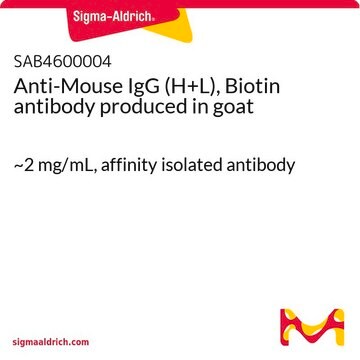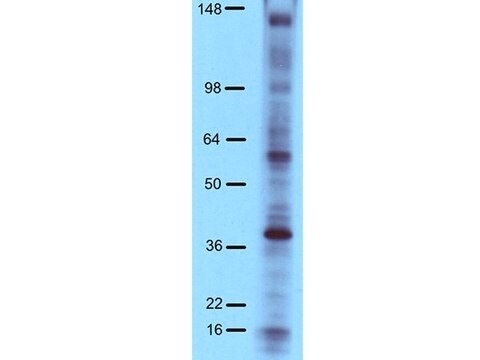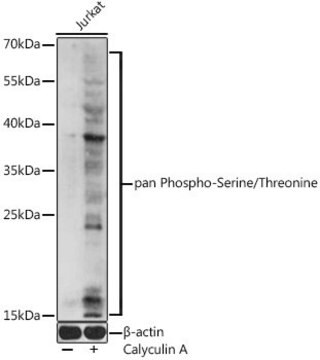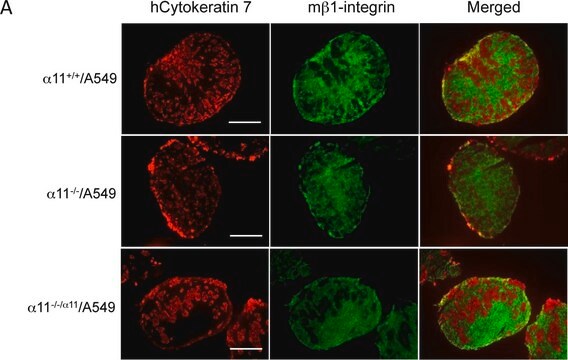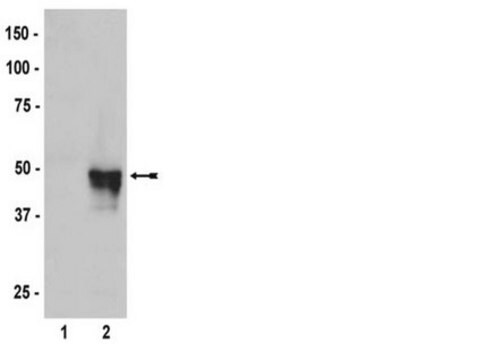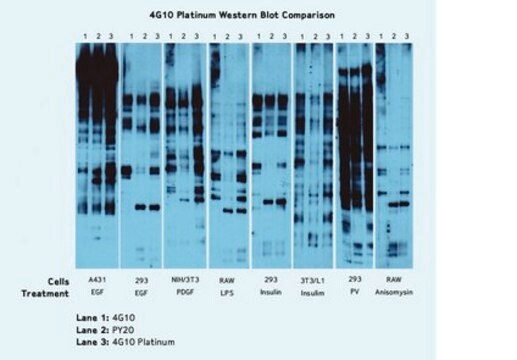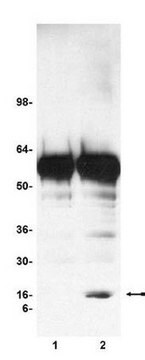17-499
Phosphorylation Explorer Pack Sample Kit
This Antibody pack contains Anti-phosphotyrosine Antibody, Anti-Phosphoserine Antibody, validated for use in WB, IF, Flow, IHC, ELISA, ICC.
Faça loginpara ver os preços organizacionais e de contrato
About This Item
Código UNSPSC:
12161503
eCl@ss:
32161000
NACRES:
NA.43
Produtos recomendados
fonte biológica
mouse
Nível de qualidade
clone
4A4
4G10® Platinum
fabricante/nome comercial
Upstate®
técnica(s)
ELISA: suitable
activity assay: suitable (kinase and phosphatase)
flow cytometry: suitable
immunocytochemistry: suitable
immunofluorescence: suitable
immunohistochemistry: suitable
western blot: suitable
Condições de expedição
dry ice
Descrição geral
4G10 Platinum
The development of the anti-phosphotyrosine, clone 4G10 in 1989 was a monumental discovery for researchers. 4G10 was the first and is the best single monoclonal antibody for the detection tyrosine phosphorylation. 4G10 is well known for its sensitivity and its ability to detect multiple tyrosine phosphorylations on numerous substrates. It has been validated by thousands of scientific and medical researchers in virtually every application and tyrosine target over the past 2 decades. To improve on something that hundred have tried and no one has succeeded, we pooled 4G10 with the next most highly regarded anti-phosphotyrosine, clone PY20 to make 4G10 Platinum. PY20 itself is a very poor substitute for 4G10, but its additive effect allow for a greater level of detection on more substrates that even 4G10 alone was not capable of.
4A4
The identification of protein phosphorylation as a regulatory mechanism originated from studies by Fischer and Krebs in the mid 1950s that later earned them the 1992 Nobel prize. It is the major mechanism for the regulation of diverse cellular processes including cell division, protein synthesis, transcriptional regulation and neurotransmission. The steady state phosphorylation of any given substrate is governed by the opposing activities of kinases and phosphatases. It is now believed that a third of all eukaryotic cellular proteins are phosphorylated and that the majority of all phosphorylation events occur on serine and threonine residues (greater than 95%).
The development of the anti-phosphotyrosine, clone 4G10 in 1989 was a monumental discovery for researchers. 4G10 was the first and is the best single monoclonal antibody for the detection tyrosine phosphorylation. 4G10 is well known for its sensitivity and its ability to detect multiple tyrosine phosphorylations on numerous substrates. It has been validated by thousands of scientific and medical researchers in virtually every application and tyrosine target over the past 2 decades. To improve on something that hundred have tried and no one has succeeded, we pooled 4G10 with the next most highly regarded anti-phosphotyrosine, clone PY20 to make 4G10 Platinum. PY20 itself is a very poor substitute for 4G10, but its additive effect allow for a greater level of detection on more substrates that even 4G10 alone was not capable of.
4A4
The identification of protein phosphorylation as a regulatory mechanism originated from studies by Fischer and Krebs in the mid 1950s that later earned them the 1992 Nobel prize. It is the major mechanism for the regulation of diverse cellular processes including cell division, protein synthesis, transcriptional regulation and neurotransmission. The steady state phosphorylation of any given substrate is governed by the opposing activities of kinases and phosphatases. It is now believed that a third of all eukaryotic cellular proteins are phosphorylated and that the majority of all phosphorylation events occur on serine and threonine residues (greater than 95%).
Aplicação
Research Category
Signaling
Signaling
Research Sub Category
General Post-translation Modification
General Post-translation Modification
This Antibody pack contains Anti-phosphotyrosine Antibody, Anti-Phosphoserine Antibody, validated for use in WB, IF, Flow, IHC, ELISA, ICC.
Componentes
Descrição-alvo
Dependent upon the molecular weight of the tyrosine phosphorylated protein being detected.
Armazenamento e estabilidade
See individual components for storage/handling conditions.
Nota de análise
Control
Positive Antigen Control: Catalog #12-302, EGF-stimulated A431 cell lysate. Add 2.5µL of 2-mercaptoethanol/100µL of lysate and boil for 5 minutes to reduce the preparation. Load 20µg of reduced lysate per lane for mingels.
Positive Antigen Control: Catalog #12-302, EGF-stimulated A431 cell lysate. Add 2.5µL of 2-mercaptoethanol/100µL of lysate and boil for 5 minutes to reduce the preparation. Load 20µg of reduced lysate per lane for mingels.
Informações legais
UPSTATE is a registered trademark of Merck KGaA, Darmstadt, Germany
Exoneração de responsabilidade
Unless otherwise stated in our catalog or other company documentation accompanying the product(s), our products are intended for research use only and are not to be used for any other purpose, which includes but is not limited to, unauthorized commercial uses, in vitro diagnostic uses, ex vivo or in vivo therapeutic uses or any type of consumption or application to humans or animals.
Código de classe de armazenamento
10 - Combustible liquids
Certificados de análise (COA)
Busque Certificados de análise (COA) digitando o Número do Lote do produto. Os números de lote e remessa podem ser encontrados no rótulo de um produto após a palavra “Lot” ou “Batch”.
Já possui este produto?
Encontre a documentação dos produtos que você adquiriu recentemente na biblioteca de documentos.
Nossa equipe de cientistas tem experiência em todas as áreas de pesquisa, incluindo Life Sciences, ciência de materiais, síntese química, cromatografia, química analítica e muitas outras.
Entre em contato com a assistência técnica
